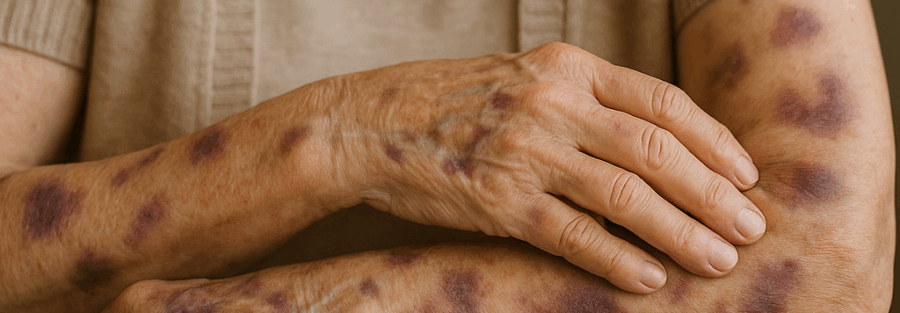I am worried about these marks on my hands. What are they? I take clopidogrel and aspirin. Male, 79
I have these bruises on my legs. I feel ashamed because people might think someone hurt me. I want them gone. What are they? Female, 30
I notice bruises more in the summer. I never paid attention until my daughter told me I should check for a blood disease. What should I do? Female, 65
These are real concerns from real people I have met in my practice, and they are questions I hear often. The skin often speaks before our blood tests do. The marks that appear can tell a story, which I would like to unravel with you in this article.
What is a hemorrhagic phenomenon?
A hemorrhagic phenomenon is any visible bleeding into the skin, mucous membranes, or deeper tissues without a break in the skin. These signs result from blood escaping from vessels into surrounding tissues. They can vary in size, color, shape, and cause.
We describe them with specific terms:
- Petechiae – tiny pinpoint red or purple spots, less than 2 mm, that do not blanch when pressed.
- Purpura – larger spots or patches, up to 1 cm, often red, purple, or brown as they fade.
- Ecchymosis – what most people call a bruise, larger than 1 cm, changing color as it heals.
- Hematoma – a raised collection of blood under the skin or in deeper tissue, sometimes painful.
Why it matters to get them checked
Sometimes these marks are harmless, the result of bumping into a table edge or carrying heavy bags. Other times, they are the first sign of a serious underlying condition involving platelets, clotting factors, blood vessels, or even the bone marrow. Treatment depends entirely on the cause, so understanding the reason is essential.
Common non-pathological causes
Bruises do not always signal disease. They can appear after small injuries you may not even remember. As we get older, the skin and small blood vessels become more fragile, and sun exposure can make them break more easily. Medications such as aspirin, clopidogrel, or corticosteroids often make bruising more noticeable. Even certain nutrient deficiencies, like low vitamin C, vitamin K, or iron, can weaken the vessel walls. Hormonal changes, especially around menopause, sometimes play a role. On the other hand, rare situations such as intestinal parasites can contribute to bruising. Similarly, high doses of vitamin E taken with anticoagulants may also increase the risk. And in some cases, intense exercise or repetitive strain can cause harmless but sometimes dramatic-looking marks.
Pathological causes
When bruising is frequent, appears without clear cause, or is accompanied by other bleeding symptoms, it may point to a deeper problem. Some causes are non-cancerous hematologic diseases like immune thrombocytopenia (ITP) or thrombotic thrombocytopenic purpura (TTP). Others involve platelet disorders such as a low platelet count or problems with platelet function. Clotting factor deficiencies like hemophilia, von Willebrand disease, or severe liver disease can also be behind the bruising. In addition, vascular disorders such as vasculitis, connective tissue disease, or scurvy may be responsible. Finally, systemic illnesses including bone marrow diseases, certain cancers, severe infections, or disseminated intravascular coagulation (DIC) can sometimes be the underlying cause.
Localised or systemic – why location matters
The distribution of bleeding signs can guide diagnosis.
- Localised bruises often point to trauma or local vessel fragility.
- Widespread petechiae or purpura can suggest platelet or clotting disorders.
- Mucosal bleeding (gums, nosebleeds) often indicates platelet or vascular causes.
- Bruising in unusual sites such as the trunk, back, or face deserves special attention.
Final message
Bruises are not a reflection of your personal life but a signal from your body. Finding the cause is not about blame, but about health and understanding.
Seek medical advice promptly when you notice any bruises.
Disclaimer:
The information presented in this article is accurate to the best of the author’s knowledge as of the publication date. However, medical knowledge and treatment guidelines are constantly evolving, and new research findings may lead to changes in the information presented here. Readers are encouraged to consult healthcare professionals or refer to the latest guidelines for up-to-date information and personalized medical advice. This article is intended for informational purposes only and is not a substitute for professional medical care.
List of References:
- McKee MD, Waddell JP, Kudo PA, Schemitsch EH. Bruising and ecchymosis: Evaluation and management. BMJ. 2020;368:m232.
- Mayo Clinic Staff. Easy bruising: Why does it happen? Mayo Clinic. Updated 2024. Available from: https://www.mayoclinic.org/diseases-conditions/easy-bruising/symptoms-causes/syc-20370557
- National Health Service (NHS). Bruising and bleeding. NHS UK. 2023. Available from: https://www.nhs.uk/conditions/bleeding-bruising
- Simon RR, Sherman SC. Bruises, purpura, and hematomas. In: Walls RM, Hwang J, editors. Rosen’s Emergency Medicine: Concepts and Clinical Practice. 10th ed. Philadelphia: Elsevier; 2023. p. 743-748.
- Clifford SM, Tuite EM. Vitamin deficiencies and skin signs: Recognition and management. Clin Dermatol. 2021;39(5):695-704.
- Gershwin ME, German JB, Keen CL. Nutrition and Immunology. In: Handbook of Nutrition and Immunity. Totowa: Humana Press; 2004. p. 125–132.
- Lippi G, Franchini M, Favaloro EJ. Vitamin E supplementation and bleeding risk: Facts and controversies. Blood Transfus. 2014;12 Suppl 1:s35-8.


